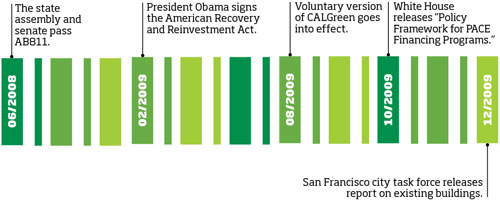California Greenin'
Existing Commercial Buildings Energy performance Ordinance
Not long after the GBO was enacted, Mayor Newsom appointed a second task force to identify strategies that would enhance the energy efficiency of the city’s existing commercial buildings. Noting in its December 2009 report that, at the historic development pace of “0.8 percent new buildings per year, it could take more than sixty years to ‘green’ even half of San Francisco,” this group stressed that the overall sustainability of the city largely depended on improving the performance of its existing building stock. The task force recommended that the city start by setting a voluntary goal to slash energy use in existing commercial properties in half by 2030, or an average net reduction of 2.5 percent per year. To reach this goal, the task force proposed a multipronged strategy rooted in the collection and dissemination of energy data. After all, the report reminds us, “what we measure, we manage.”
 |
Based on the task force’s recommendations, the city adopted the Existing Commercial Buildings Energy Performance Ordinance in early 2011. The new regulations, which form Chapter 20 of the city’s Environment Code, require owners of nonresidential buildings in San Francisco that are larger than 10,000 square feet and at least five years old to obtain energy-efficiency audits every five years and report energy consumption yearly to SF Environment. They also require SF Environment to make publicly available summary statistics regarding the energy performance of these buildings.
Properties that are vacant or were constructed within the past two years are exempt from submitting the annual performance statistics. And buildings are not required to undergo an audit if they have already demonstrated solid energy management by being certified under the LEED rating system for Existing Buildings Operations and Maintenance within five years or receiving a U.S. Environmental Protection Agency Energy Star label for at least three of the past five years. Unoccupied buildings and facilities in financial distress can apply for an extension to comply with the law’s requirements.
The five-year audit must identify a list of strategies currently available to the owner to increase the building’s energy efficiency, the estimated cost to implement such strategies, and the estimated energy savings if implemented. The yearly reporting of energy performance—known as the Annual Energy Benchmark Summary, or AEBS—must be accomplished through Portfolio Manager, a free tool provided by EPA Energy Star. The online application allows users to track their own progress from year to year and make easy energy-use comparisons among buildings of similar size, program, and climatic region.
According to results of an EPA study released in October, more than 35,000 buildings participating in Portfolio Manager nationwide from 2008 to 2011 realized an average annual energy savings of 2.4 percent. “These findings show the power of information,” says Cliff Majersik, executive director of the Institute for Market Transformation, a Washington, D.C.–based nonprofit organization dedicated to promoting energy efficiency, green building, and environmental protection. “Energy Star benchmarking is a powerful tool to guide and motivate building improvements to cut waste and save big money.”
A three-year phase-in period for existing-building audits and performance reports started in San Francisco in 2011. The buildings that have complied to date by benchmarking and reporting energy performance are noted on an online map at an independent social-networking site (honestbuildings.com/sf-ecb). According to SF Environment’s Hooper, a building’s performance statistics will be available on the same website, in addition to the city department’s own site, starting in December 2012.
In a city where green competition appears to thrive, policymakers are betting that making energy consumption transparent to potential tenants and investors-—in combination with favorable financing and existing rebates—will give existing-building owners enough incentive to improve energy efficiency to maintain their edge in the marketplace.









